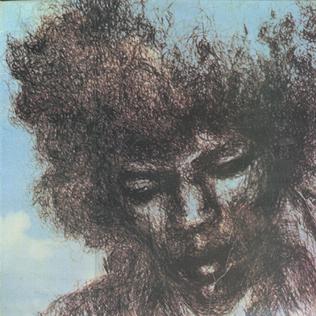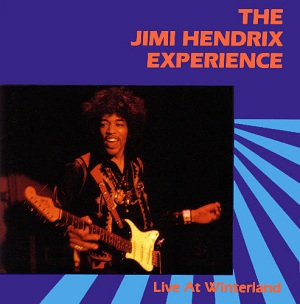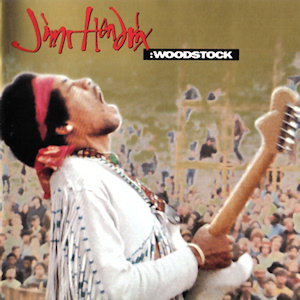
Electric Ladyland is the third and final studio album by the Jimi Hendrix Experience, released in October 1968. A double album, it was the only record from the Experience with production solely credited to Hendrix. The band's most commercially successful release and its only number one album, it was released by Reprise Records in the United States on October 16, 1968, and by Track Records in the UK nine days later. By mid-November, it had reached number 1 on the Billboard Top LPs chart, spending two weeks there. In the UK it peaked at number 6, where it spent 12 weeks on the British charts.

Are You Experienced is the debut studio album by the Jimi Hendrix Experience, released in May 1967. The album was an immediate critical and commercial success, and is widely regarded as one of the greatest albums of all time. It features Jimi Hendrix's innovative approach to songwriting and electric guitar playing, which soon established a new direction in psychedelic and rock music as a whole.

Axis: Bold as Love is the second studio album by the Jimi Hendrix Experience. It was first released by Track Records in the United Kingdom on December 1, 1967, only seven months after the release of the group's highly successful debut album, Are You Experienced. In the United States, Reprise Records delayed the release until the following month. The album reached the top ten in the album charts in both countries.
"Little Wing" is a song written by Jimi Hendrix and recorded by the Jimi Hendrix Experience in 1967. It is a slower tempo, rhythm and blues-inspired ballad featuring Hendrix's vocal and guitar with recording studio effects accompanied by bass, drums, and glockenspiel. Lyrically, it is one of several of his songs that reference an idealized feminine or guardian angel-like figure. At about two and a half minutes in length, it is one of his most concise and melodically focused pieces.

Smash Hits is a compilation album by the Jimi Hendrix Experience. Track Records first issued it on April 12, 1968, in the UK and included all four of the group's singles released up to that time, plus four additional songs from the UK edition of Are You Experienced.

First Rays of the New Rising Sun is a compilation album credited to American rock musician Jimi Hendrix, issued in April 1997 on MCA Records. Featuring songs mostly intended for his planned fourth studio album, it was one of the first releases overseen by Experience Hendrix, the family company that took over management of his recording legacy. It reached the album charts in the United States, United Kingdom, and four other countries.

Blues is a compilation album of blues songs recorded by American singer/songwriter/musician Jimi Hendrix. Compiled by interim Hendrix producer Alan Douglas, it was released April 26, 1994, by MCA Records. The album contains eleven songs recorded by Hendrix between 1966 and 1970, six of which were previously unreleased. Hendrix wrote seven of the pieces; other writers include Muddy Waters, Booker T. Jones, and Elmore James. Most are demos, jams, and live recordings, which Hendrix may or may not have completed for release.

Hendrix in the West is a live album by Jimi Hendrix, released posthumously in January 1972 by Polydor Records (UK), and in February by Reprise Records (US). The album tracks are split between those recorded in 1969 by the Jimi Hendrix Experience with bassist Noel Redding and drummer Mitch Mitchell and in 1970 with Billy Cox and Mitchell during The Cry of Love Tour.

The Cry of Love is the first posthumous album of music by the American rock singer-songwriter and guitarist Jimi Hendrix. Recorded primarily in 1970, it features new material that Hendrix was working on for his planned fourth studio album before his death later that year. While most of the songs were included on proposed track listings by Hendrix, the final selection was made by recording engineer Eddie Kramer and drummer Mitch Mitchell, with input from manager Michael Jeffery. Hendrix, Kramer, and Mitchell are credited as the album's producers, with Jeffery as the executive producer.

Historic Performances Recorded at the Monterey International Pop Festival is a live album recorded at the Monterey Pop Festival in June 1967. A split artist release, it includes some of the performances by the Jimi Hendrix Experience on side one and Otis Redding on side two. It has been supplanted by later more comprehensive releases, Live at Monterey and Captured Live at the Monterey International Pop Festival .

Soundtrack Recordings from the Film Jimi Hendrix is the soundtrack to the documentary film Jimi Hendrix (1973). The double album was released by Reprise Records in July 1973. It contains the full-length live performances from the film and some clips from interviews. The album peaked at number 89 on the Billboard album chart, which generated concern at Reprise Records that repackaging old material would no longer satisfy the fans of Jimi Hendrix. The album has not been released on compact disc.

Nine to the Universe is a posthumous compilation album by American guitarist Jimi Hendrix. It was released in March 1980 in the US and in June 1980 in the UK. It was the third album of Hendrix recordings to be produced by Alan Douglas.

Rainbow Bridge is a posthumous album by American musician Jimi Hendrix. It was released in October 1971 through Reprise Records, and was produced by Mitch Mitchell, Eddie Kramer, and John Jansen, with Hendrix receiving a production credit as well. The album was the second released after Hendrix's death to consist primarily of previously unreleased studio material, much of which was intended for a potential fourth studio album.

Johnny B. Goode is a live album by Jimi Hendrix, released posthumously in June 1986. It contains three songs from Hendrix's performance at the 1970 Atlanta International Pop Festival on July 4, 1970, and two songs, including the title track, from a performance at the Berkeley Community Theater on May 30, 1970.

Band of Gypsys 2 is a posthumous live album by American rock musician Jimi Hendrix, released in October 1986 by Capitol Records. Produced by Alan Douglas, it followed the live mini LP Johnny B. Goode (1986), which also included live recordings from the Atlanta International Pop Festival (1970) and the Berkeley Community Theatre (1970).

Live at Winterland is a live album by The Jimi Hendrix Experience. It compiles performances from the band's three concerts at the Winterland Ballroom in San Francisco, where they played two shows each night on October 10, 11 and 12, 1968. The album was released posthumously by Rykodisc in 1987 and was the first Hendrix release to be specifically conceived for the compact disc format.

Woodstock is a live album by Jimi Hendrix released posthumously on August 20, 1994. It presents some of Hendrix's performance at Woodstock Festival on August 18, 1969. The album was replaced by a more-complete version in 1999 titled Live at Woodstock, albeit with some of the performances edited.

Radio One is a live album by The Jimi Hendrix Experience. It was released posthumously in November 1988 by Rykodisc and compiles tracks recorded between February and December 1967 for broadcasts by BBC Radio. The album peaked at number 30 on the UK Albums Chart while it charted at number 119 on the Billboard 200 in the United States. After Hendrix's family gained control of his legacy, Radio One was supplanted by the more comprehensive BBC Sessions in 1998.

Jimi Hendrix (1942–1970) was an American guitarist whose career spanned the years between 1962 and 1970. His posthumous discography includes recordings released after September 18, 1970. Hendrix left behind many recordings in varying stages of completion. This material, along with reissues of his career catalogue, has been released over the years in several formats by various producers and record companies. Since Experience Hendrix, a company owned and operated by members of the Hendrix family, took control of his recording legacy in 1995, over 15 Hendrix albums have appeared on the main US albums chart. Several of these have also placed on charts in more than 18 countries around the world.
















